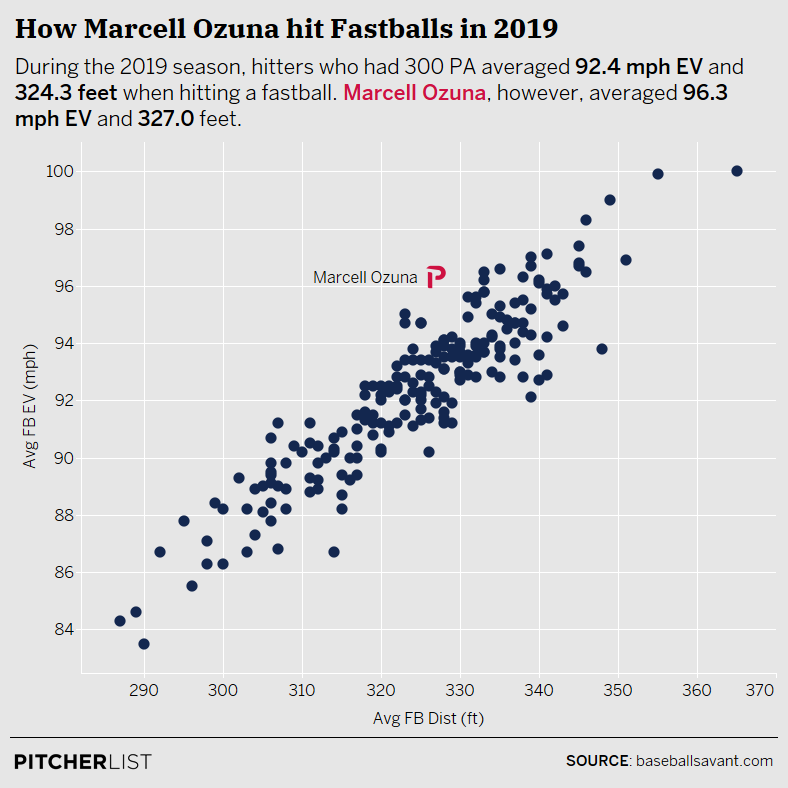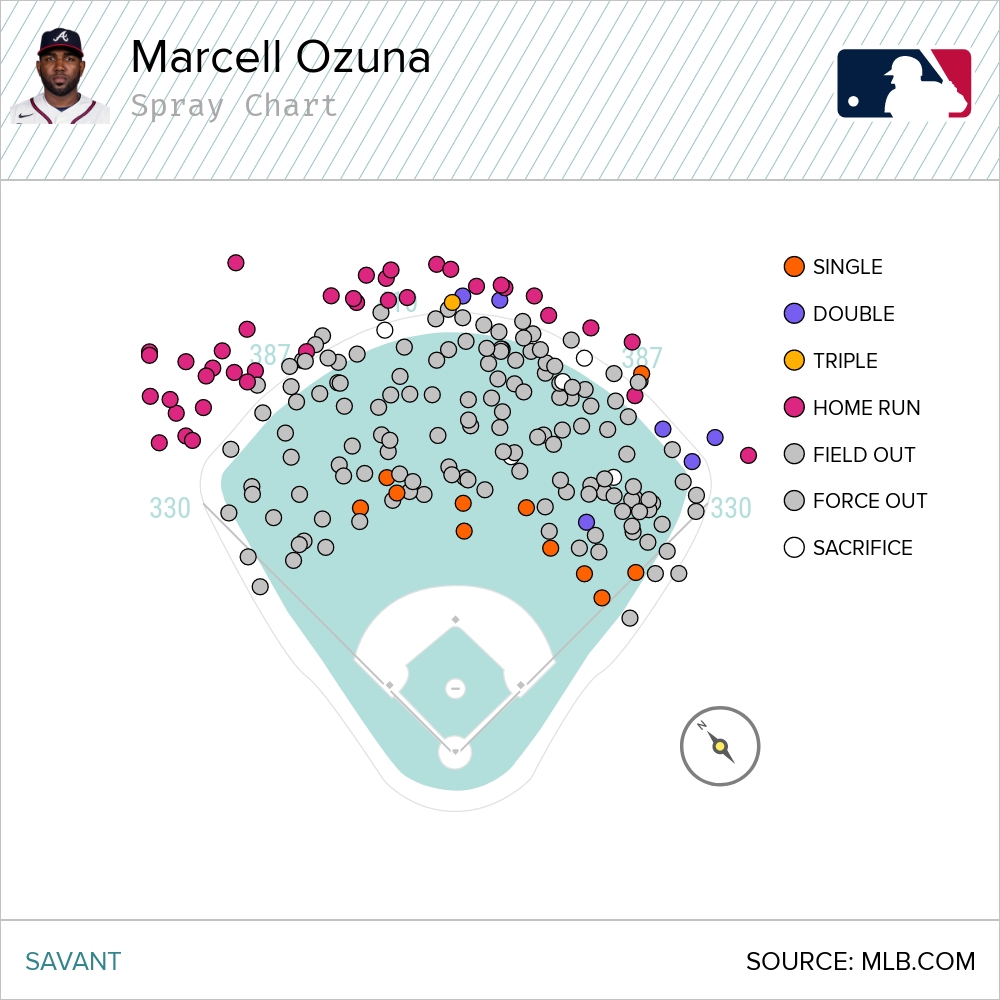If you only looked at Marcell Ozuna’s Statcast profile in the past two seasons, you would maybe think that he was one of the best hitters in the game. There was a lot of red in his profile, and especially so in 2019. He has consistently posted average exit velocity marks that were in the top ten percent of the league, and last season his 49.2% hard-hit rate was inside the top four percent of the league, which led him to have expected slugging and wOBA marks that were in the top ten percent of the league as well. That sounds like quite the hitter! Indeed, there has always been a lot to like about Ozuna’s profile since his breakout season in 2017.
Unfortunately for him though, the game is not played using expected statistics. While expected stats paint him in an elite way, the more important actual ones paint him in a much different way. Ozuna has been far from a bad player over the course of his career, but when his actual results are compared to his Statcast metrics, he could be viewed as somewhat underwhelming. Since his monster breakout season in 2017 in which he posted 37 home runs and a 143 wRC+, he has continued to post solid home run totals, including 29 in just 138 games a season ago, but that was pretty much it. By wRC+, Ozuna has not been much better than league average in the last two seasons, with just a 107 and 109 mark in 2018 and 2019, respectively. After two consecutive years of this being the case, the consensus about Ozuna was perhaps starting to shift to the view that he was just one of those players that perenially underachieves his Statcast metrics.
That’s certainly not a group that any player wants to be lumped into, but fortunately for Ozuna, that view is starting to look incredibly silly. This season has been completely different for him, as he remains one of the best hitters on paper in terms of Statcast stats, but he is also living up to it and putting down the actual results that are making him look like a legitimate star at the moment. His 164 wRC+ is inside the top-ten among qualified hitters and ditto for his 14 home runs. With Ozuna in the same lineup as Ronald Acuña Jr. and Freddie Freeman, the Braves have one of the scariest lineups in baseball. All this while a lot of the thinking coming into the season was that they pretty much had to “settle” for Ozuna as a Josh Donaldson replacement after missing out on some other big-name offensive free agents. Ozuna’s underperformance the past two seasons didn’t make the most “desirable” free agent, but he is making a lot of front offices look quite foolish right now and he is setting himself up for quite the payday as he enters the market again this winter.
A lot of Ozuna’s underperformance the past two seasons can mostly be attributed to his fly balls. In those two seasons combined, Ozuna had a .930 slugging percentage on those balls, which, like the rest of his overall game, lagged greatly behind his expected slugging percentage:
| Player | SLG | xSLG | Difference |
|---|---|---|---|
| Marcell Ozuna | 0.930 | 1.147 | -0.217 |
| Alex Gordon | 0.661 | 0.866 | -0.205 |
| Tommy Pham | 1.125 | 1.300 | -0.175 |
| Nick Castellanos | 0.903 | 1.071 | -0.168 |
| Jose Abreu | 1.113 | 1.264 | -0.151 |
Among hitters with at least 1,000 plate appearances over those two years, Ozuna had the largest difference between his actual and expected slugging on fly balls. Ozuna did have a slight difference in his line-drives over these same two seasons, but the difference is marginal at just 0.073, which was not very close to the top of the leaderboard. There should then be little debate that most of the issue for Ozuna has been his fly balls not performing up to snuff, and this can be seen when evaluating some of his hardest-hit fly balls. The expected results on these balls are outstanding, but they do not end up getting the most desirable actual results. There have been many examples of this in the last two years by Ozuna, but here is a truly notable one:
This ball was struck at 104 mph off the bat at a 27° launch angle. Similar batted balls have a .920 expected batting average and are home runs around 84% of the time. Additionally, these batted balls travel around 410 feet on average, but for Ozuna, this ball goes only 385 feet and dies at the warning track, which is obviously far from ideal. Again, there were many examples of similar batted balls like this that are hit extremely hard and that generally get desirable results, and where that was often not the case for Ozuna. In watching a lot of these clips with full sound and commentary, a common theme is the roar of the crowd and some variation of Cardinals broadcaster Ban McLaughlin saying that Ozuna “just missed it”. Pretty much every single person in the ballpark thought these balls from Ozuna were home runs off the bat and for good reason, too. The vast majority of the time, a lot of these balls are home runs, but for Ozuna, they were falling just short of the fence for outs. These batted balls look and sound good off the bat, and also look good for expected stats, but in Ozuna’s case, not for the actual ones. Have enough of these start to pile up, and we get a good explanation for why Ozuna’s actual stats on fly balls trailed his expected ones so greatly.
It’s not exactly a flaw in the expected stats to paint Ozuna in such a flattering light in this department. They are simply just doing their job in trying to tell, based on batted ball data, a more complete story about each hitter. Ozuna hits the ball well very often, so expected stats are going to believe that he should do well more often than not. This does bring up an interesting topic though, in trying to see just how much of an outlier Ozuna was last season. Ozuna clearly hits his fly balls well, as evidenced by his 96.3 mph average exit velocity on those balls in 2019, a mark that placed him inside the top-20 of all hitters that had 300 plate appearances. That did not seem to translate well though to a high average fly ball distance, as shown by the graph below:

From this, we see how much Ozuna (indicated by the red P) stands out. Generally speaking, average exit velocity on fly balls is a good indicator of average fly ball distance, as well as overall home run per fly ball rate, but Ozuna looked very much so like an outlier in this aspect last season. Ozuna’s 327 feet of average fly ball distance last season was more in line with hitters who hit fly balls around 92 or 93 mph instead of Ozuna’s elite rate. This does not appear to be the case for Ozuna this season, however. Doing the same exercise with 2020 numbers, shows Ozuna in a much more favorable light:

Ozuna is still one of the game’s best in terms of average fly ball exit velocity this season, but we also notice that Ozuna has gained quite a few ticks in feet of average fly ball distance. Ozuna is now no longer an outlier and his fly balls are going at a distance that is much more in line with expectations. We’ll get into why he has all of a sudden caught up this season a little bit later, but for now, let’s evaluate just how much damage Ozuna’s fly balls are doing this season.
Ozuna’s fly balls are performing much better as a whole this season, and are among the best in the game. Going back to his average distance, Ozuna has added 11 feet to his average fly ball distance this season to bring him up to 338 feet, which is one of the top-20 biggest improvements from 2019 to 2020, and overall, that 338 feet mark is also good enough to land him in the top-20 of the average fly ball distance leaderboard.
More importantly, perhaps, is that his added distance is allowing his fly balls to do a lot more. Taking a look at his results on fly balls from 2017 to 2020, we can see just how much better Ozuna has gotten, and that he has pretty much returned to his breakout 2017 season form:
| Year | SLG | wOBA | ISO |
|---|---|---|---|
| 2017 | 1.242 | 0.614 | 0.909 |
| 2018 | 0.827 | 0.440 | 0.545 |
| 2019 | 1.056 | 0.524 | 0.756 |
| 2020 | 1.276 | 0.627 | 0.897 |
Not only is Ozuna getting better results on his fly balls this season and back to his 2017 ways, but his results also rank extremely well in the context of the rest of the league. His slugging, isolated power, and wOBA marks are all in the top-20 of the league. Just like in years past, Ozuna also ranks favorably in terms of expected stats this season, as he ranks eighth in both expected slugging and expected wOBA on fly balls. The difference, of course, is that this season Ozuna is matching those strong expected stats with strong actual ones as well, which is ultimately making the difference in Ozuna taking his game this season to the next level.
Also helping with Ozuna’s elevated performance this season has been him continuing his trend of pulling the ball. In 2017, Ozuna only pulled the ball 33.1% of the time. In the years since that rate has been steadily climbing up and now in 2020, it is over ten percentage points higher than it was in 2017 at 43.4%. Ozuna has been one of the best hitters in 2020 when hitting batted balls to the pull side in terms of both slugging and wOBA, another instance of that being the case for him this season. This trend has also crept into his fly balls, as Ozuna has gradually increased his pulled fly ball rate from 2017 to this current season:
| Year | Total Fly Balls | Pulled Fly Balls | Pulled Fly Ball % |
|---|---|---|---|
| 2017 | 99 | 28 | 28.3% |
| 2018 | 114 | 26 | 22.8% |
| 2019 | 91 | 32 | 35.2% |
| 2020 | 28 | 9 | 32.1% |
It is good to see that with Ozuna’s steady increase in overall pull rate over the past few years, his pulled fly ball rate has been trending up as well. Pulled fly balls are generally a desirable result for hitters, as hitters usually get their best power results on pulled fly balls. For Ozuna though, his pulled fly balls ran into the same issues as the rest of his fly balls in that they were not carrying as much and he ended up with outcomes that were far off the pace that he set in 2017. This season, as is the case for all of his fly balls, this issue has been corrected:
| Year | Pulled Fly Ball % | SLG | wOBA | AVG Distance |
|---|---|---|---|---|
| 2017 | 28.30% | 2.393 | 1.207 | 375 |
| 2018 | 22.80% | 1.538 | 0.781 | 352 |
| 2019 | 35.20% | 1.531 | 0.755 | 338 |
| 2020 | 32.10% | 2.556 | 1.310 | 374 |
While Ozuna’s slugging and wOBA numbers in 2017 and 2018 look good on the surface, knowing what good slugging and wOBA numbers on pulled fly balls are isn’t something that most people probably know, so some additional context is needed. Obviously, Ozuna was better in this department in 2017 and is better now, but just how much better? Ozuna ranked 219th out of 273 hitters on both slugging and wOBA on pulled fly balls in 2019 and did not rank much better in 2018 either. This season though, Ozuna is currently performing at an even better level than he was in 2017, and the main reason appears to be a surge in his average distance, which combined with his still excellent and better hard-hit ability, has propelled him towards the top of the pulled fly ball leaderboard.
So, we know what it is about Ozuna’s game that has brought about the best version of himself this season, but what has actually changed for Ozuna this season that has gotten him to this point? It is not some sudden revelation in his game, as he is still doing all of the same things that had held him in a favorable light by Statcast in previous seasons. Sure, he has a higher barrel and hard-hit rate, but those gains alone are probably not the full story.
One plausible theory is that Ozuna has not been fully recovered from a lingering shoulder injury until now. Ozuna had a nagging shoulder injury starting in his first season with the Cardinals back in 2018, that required surgery that offseason. While a lot was made about the effects of that injury had on his defense, it is likely that it had an impact on his offense as well. Even with a full offseason to recover, the shoulder injury was still a factor for Ozuna in 2019.
One side effect that this likely has had was for Ozuna’s fly balls to develop a much-dreaded slice, more details of which and I definitely recommend checking out can be found here, here, and here. The short of it is that the result of a slice is less carry, which helps explain Ozuna’s average fly ball distance looking low the past two seasons, especially when compared to his exit velocity on fly balls, but also, fly balls traveling to the less desirable part of the field. Essentially, that means that more of Ozuna’s long fly balls are going to the deepest portion of the ballpark, where they have a further distance needed to clear the fence. See, for example, Ozuna’s fly ball spray chart from 2018 and 2019 combined (on the left) compared to a spray chart showing his 2017 and 2020 fly balls (on the right):


The most notable thing from the 2018 and 2019 spray chart should be the large number of fly balls that appear to have lost their steam right around the warning track and that the majority of them are in centerfield, or just to the right of dead centerfield. Overall, there is not a big cluster of fly balls going to the right-center field portion of the field in the second spray chart as compared to the first one. A lot of those 2018 and 2019 fly balls are, for the most part, hard-hit balls that would have been home runs if they were hit to the pull side. It looks like that, in 2018 and 2019, even when Ozuna was hitting fly balls far, a lot of them were still falling short of the fence, and that can be partially explained by the slice that he developed, perhaps due to the effects of a lingering shoulder injury that had yet to fully heal until this season.
That’s essentially it. It appears that Ozuna’s success this season is less attributed to him making huge strides at the plate, although he should still be credited for hitting a greater number of balls hard, as he has been one of the best hitters in the game this season in terms of barrel, hard-hit rate, and average exit velocity, even more so than he was in past seasons. He is mostly continuing to do the same things at the plate that made him such a Statcast darling for the majority of his career. The difference this year can mostly be attributed to his fly balls catching up to previous years’ expectations, as they are carrying further than ever, which is translating to a greater rate of fly balls that carry over the fence. Additionally, Ozuna is continuing to pull a good amount of his fly balls, which now, with the added distance boost that his overall fly balls are getting, he has gone from getting some of the worst results on pulled fly balls to now getting some of the best.
After underachieving relative to his expected statistics in the last two seasons, perhaps mostly due to things that were beyond his control, Ozuna is making up for it this season and is having an even better season this year than his previous best season in 2017. This season, Ozuna has shattered all expectations that were placed upon him upon signing with the Braves. He has gone from being a not-as-good replacement for Josh Donaldson and a more complementary piece in the Atlanta lineup to one of the big forces in their lineup, as they look to mash their way to the World Series later this year.
Photo by Rich von Biberstein/Icon Sportswire | Adapted by Justin Paradis (@freshmeatcomm on Twitter)



